Prodotti Tradizionali della Campania
MOZZARELLA NELLA MORTELLA

La mozzarella “co’ a mortedda”, è un formaggio a pasta filata ottenuto dalla trasformazione del latte di vacca, la cui zona di produzione tradizionale è individuabile in pochi comuni del basso Cilento nel Salernitano. La denominazione nasce dall’usanza di confezionare le mozzarelle, di forma allungata e più o meno piatta, la cosiddetta “mozzarella stracciata”, alternandole a fronde di mirto appena raccolte successivamente legate alle estremità coi rami sottili e flessibili delle ginestre. Generalmente queste confezioni dette “ mazzi” contengono 6-10 mozzarelle. Anticamente la mozzarella veniva prodotta vicino alle zone dove gli animali venivano fatti pascolare e si presentava dunque l’esigenza di conservarla in involucri che la proteggessero durante il trasporto fino ai paesi dove veniva venduta. Si è scelto di utilizzare il mirto, o mortella, perché oltre a essere pianta sempreverde, è facilmente reperibile come essenza spontanea nelle zone di pascolo del Cilento, e perché conferisce al prodotto un aroma molto particolare. Una particolarità nella lavorazione consiste nel far maturare la cagliata, dopo la rottura, in assenza, o quasi, di siero il che conferisce al prodotto una consistenza compatta e asciutta con una pellicola esterna particolarmente doppia. Questo formaggio è particolarissimo e va consumato dopo essere stato scartato dal mirto; conserva l’impronta delle foglie e dei rami sulla forma e, soprattutto, il suo aroma.
![]() Mozzarella “co’ a
mortedda”, is a cheese a pasta filata obtained from the transformation
of cow milk and its traditional production can be found in few towns
of lower Cilento, in the province of Salerno. The name comes from the
custom of packaging the mozzarelle, in long and flat shapes, the so called “mozzarella
stracciata” (torn mozzarella), alternating them to freshly picked
myrtle twigs and then tied at the ends with thin and flexible branches
of broom. These packages were generally called “mazzi” (bunches)
and contained about 6-10 mozzarelle. Anciently mozzarella was produced
near the areas where the animals were bread and there was the need of
preserving it in packages that could protect it during transportation
to the nearby towns where it was then sold. The choice of using myrtle,
also known as mortella, is because it’s an evergreen plant and
it can be easily found since it grows spontaneously in the Cilento pasture.
It is also used because it gives a particular aroma to the product. A
peculiarity of the transformation is to let the curd age, after the breakage,
with hardly any whey, and this gives the product a compact and dry consistency
with a rather thick external film. This cheese is very particular and
it is eaten after removing the myrtle package; it maintains the imprints
of the leaves and the branches and especially the aroma.
Mozzarella “co’ a
mortedda”, is a cheese a pasta filata obtained from the transformation
of cow milk and its traditional production can be found in few towns
of lower Cilento, in the province of Salerno. The name comes from the
custom of packaging the mozzarelle, in long and flat shapes, the so called “mozzarella
stracciata” (torn mozzarella), alternating them to freshly picked
myrtle twigs and then tied at the ends with thin and flexible branches
of broom. These packages were generally called “mazzi” (bunches)
and contained about 6-10 mozzarelle. Anciently mozzarella was produced
near the areas where the animals were bread and there was the need of
preserving it in packages that could protect it during transportation
to the nearby towns where it was then sold. The choice of using myrtle,
also known as mortella, is because it’s an evergreen plant and
it can be easily found since it grows spontaneously in the Cilento pasture.
It is also used because it gives a particular aroma to the product. A
peculiarity of the transformation is to let the curd age, after the breakage,
with hardly any whey, and this gives the product a compact and dry consistency
with a rather thick external film. This cheese is very particular and
it is eaten after removing the myrtle package; it maintains the imprints
of the leaves and the branches and especially the aroma.